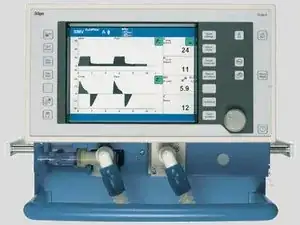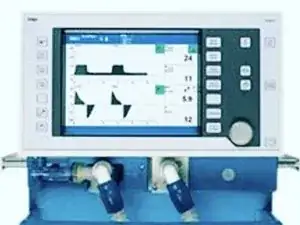Background
The Drager Evita 4 is an intensive care ventilator that supports multiple ventilation modes, which are the following: IPPV (CPPV, PLV, AutoFlow, IRV), SIMV (PLV, AutoFlow), MMV (PLV, AutoFlow), SB, CPAP, ASB, BIPAP, BIPAP Assist, APRV, PPS and ILV. It also monitors airway pressure, expiratory minute volume, inspiratory tidal volume, inspiratory O2 concentration, inspiratory breathing gas temperature, apnoea time, tachypnoea, and expiratory CO2 concentration. If a gas failure is detected, the ventilator will automatically switch to the next functional gas supply available. The Drager Evita 4 supports MEDIBUS, a software protocol that allows data transfer between the Evita 4 and an external medical or non-medical device. The intended user group of this device is patients in intensive care that are suffering from respiratory conditions where a ventilator may help.
The Drager Evita 4 has had two recalls by the FDA. In June 2003, the FDA initiated a recall for Evita 4 ventilators with catalog numbers 4116640 and 8412980. The reason for the recall was that there were software problems such as “ventilation mode changes without user input, settings change without corresponding display change, and false auto-set alarm.” Five years later, in September 2008, the FDA initiated another recall for Evita 4 ventilators with catalog number 8411900. The reason for this recall was because the “audible power failure alarm was not enunciated at the required volume.” In other words, the two components that have had the most severe problems in the past are the motherboard (software) and the power failure alarm.
The Drager Evita line is complemented by the Drager Babylog line of neonatal ventilators, as well as the Drager Oxylog line of Emergency and Transport Ventilators. The Drager Evita 4 has been replaced by the Drager Evita Infinity V500.
Identification
To identify the Drager Evita 4, the top-left of the front of the device should have the Drager logo, and the top-right of the front of the device should be labelled “Evita 4”. There is a screen with seven buttons on the left side of it and thirteen buttons and a rotary knob on the right side of the screen. The standby button is the lower-right most button. There are two ports on the lower part of the front of the device, one for expiration and one for inspiration. There are two handles on the side of the device. Two gas connections, a fan, and a power cord port can be found at the back of the Evita 4. The power on/off switch with a protective flap can be found in the top-left of the back of the device, near the fan.
The Drager Evita 4 edition is identical to the Evita 4, therefore this page is just as useful. To distinguish the Drager Evita 4 edition from the Evita 4, the top-right of the front of the device should be labelled “Evita 4 edition.”
Sources:
Drager Evita 4 Official Instructions for Use
Drager Evita 4 Official Short Guide
Drager Evita 4 2003 FDA Recall
Drager Evita 4 2008 FDA Recall
Technical Specifications
Dimensions (W x H x D)
- Basic machine: 530 x 290 x 450 mm
- Machine with trolley: 580 x 1335 x 660 mm
- Weight
- Basic machine approx. 27 kg
- Basic machine with trolley incl. cabinet 8H approx. 69 kg
Electrical Specifications
- Mains power connection: 100 V to 240 V, 50/60 Hz
- Current: 3.2 A to 1.2 A
- Power consumption: typically approx. 125 W
- Machine fuses
- Range 100 V to 240 V: F 5 H 250 V IEC 127-2 (2x), subject to technical modifications. Device labels must be observed.
Gas supply
- O2 gauge pressure: 3 bar –10 % to 5.5 bar +10 %
- Requirement for the central gas supply system1): at least 60 L/min continuous flow and 200 L/min peak flow for at least 4 s
- Requirement for the supply breathing air compressor from compressed gas cylinders1): at least 30 L/min continuous flow from a breathing air compressor and 180 L/min peak flow for at or least 0,8 s
- O2 connection thread: depending on configuration: DIN, NIST, DISS, Air Liquide
- Air gauge pressure: 3 bar –10 % to 5.5 bar +10 %
- Requirement for the supply system1): at least 60 L/min continuous flow central gas and 200 L/min peak flow for at least 4 s
- Requirement for the supply from a breathing air compressor or from compressed gas cylinders: at least 30 L/min continuous flow and 180 L/min peak flow for at least 0,8 s
- Air connection: depending on configuration: DIN, NIST, DISS, Air Liquide
- Dew point: 5 °C below ambient temperature
- Oil concentration: <0,1 mg/m3
- Particle size: Dust-free air (filtered with pore size <1 µm)
- Gas consumption of control system: Medical air or O2 approx. 3.5 L/min
- Output for pneumatic: Medical air or O2
- Medication nebulizer: max. 2.25 bar, max. 11 L/min
- Automatic gas switch-over: If one gas fails (inlet pressure <1.5 bar), the device switches to the other gas
Sound pressure level
- Alarm sound pressure level : max. 47 dB (A)
of the device during operation - Operator’s position: at front of device
- Free field measurement in accordance with ISO 3744: at a distance of 1 m (39 in) and a height of 1.5 m (59 in)
- Alarm sound pressure level of the acoustic alarm generator (speaker): 60 dB(A) to 85 dB(A), adjustable
- Alarm sound pressure level of the mains supply failure alarm and auxiliary alarm at the rear of the device: 70 dB(A) to 85 dB(A)
Temperature Specifications
In operation
- Temperature: 10 to 40 °C
- Atmospheric pressure: 700 to 1060 hPa
- Rel. humidity: 5 to 90 %, without condensation
In storage and transport
- Temperature: –20 to 60 °C
- Atmospheric pressure: 500 to 1060 hPa
- Rel. humidity: 0 to 100 %
Source: Drager Evita 4 Official Instructions for Use


